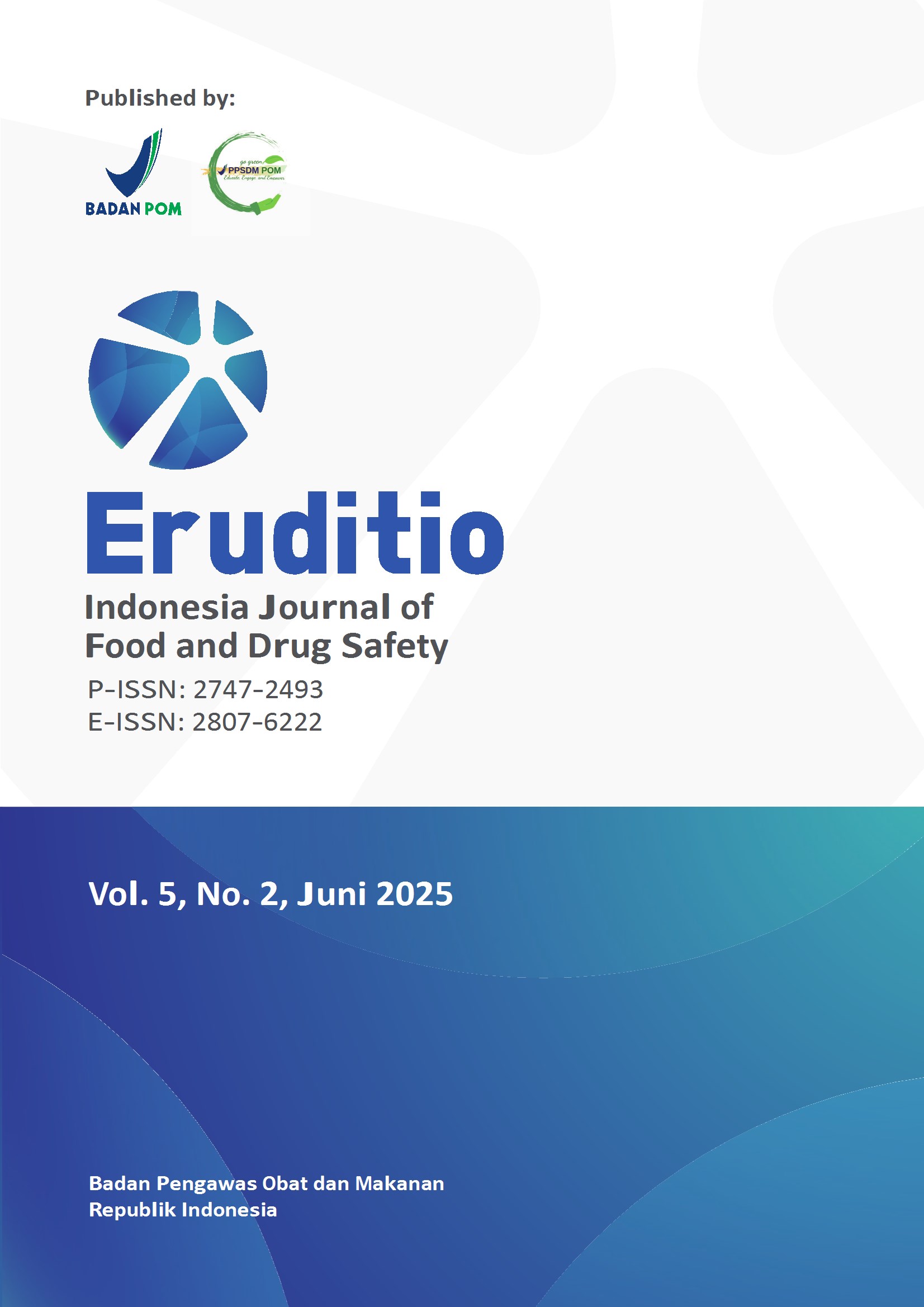Main Article Content
Abstract
Antiseptic tissue to help clean the skin in men's sensitive areas (magic tissue) is a class I (low risk) health supplies product. Several marketed products are also claimed to have benefits for preventing premature ejaculation, which is suspected to be associated with the addition of lidocaine that is not disclosed on the product label. Lidocaine, an amide local anesthetic, is used in medicine to inhibit the sensation of pain. This research was conducted to determine the lidocaine content in magic tissue. The research method used is an experimental method, involving validation methods and testing samples. Lidocaine was identified using Gas Chromatography Mass Spectrometry, with test parameters of specificity, Limit of Detection, stability test, and resistance test. Sample preparation was carried out by dissolving one layer of tissue as a sample using methanol. The Standard Solution used is lidocaine compound with a concentration of 100 ppm. The results confirmed method specificity, as the sample and spiked solutions showed identical ion extracts, fragmentation, and intensity ratios to the standard solution. The LOD was determined to be 10 ppm, indicating sufficient sensitivity. Stability testing showed consistent mass-to-charge spectra between the first and fifth days, while resistance testing demonstrated that temperature variations affected peak retention times but not the mass spectra. Analysis of five different samples revealed positive results for lidocaine. Overall, these findings indicate that the developed GC-MS method meets validation parameters and can be reliably applied to identify lidocaine in magic tissue products.
Keywords
Article Details

This work is licensed under a Creative Commons Attribution 4.0 International License.
References
- Huber, L. (2010). Validation of analytical method (Publication No. 5990.5940EN). Agilent Technologies.
- Johansson, A. J. (2012). Inga Fischer-Hjalmars (1918–2008): Swedish Pharmacist, Humanist, and Pioneer Quantum Chemist. Journal of Chemical Education, 89(10), 1274–1279. https://doi.org/10.1021/ed300024g
- Karnina, R., Arif, S. K., Hatta, M., & Bukhari, A. (2021). Molecular mechanisms of lidocaine. Annals of Medicine and Surgery, 69, 102733. https://doi.org/10.1016/j.amsu.2021.102733
- Ministry of Health, Republic of Indonesia. (2020). Indonesian Pharmacopoeia (6th ed.). Ministry of Health.
- Ministry of Health, Republic of Indonesia. (2017). Regulation of the Minister of Health Number 62 of 2017 concerning distribution permits for medical devices, in vitro diagnostic devices, and household health supplies.
- Ministry of Health, Republic of Indonesia. (2021). Regulation of the Minister of Health Number 3 of 2021 concerning changes in the classification and category of medicines.
- The Indonesian Food and Drug Authority. (2010). Guidelines for method validation.
- The Indonesian Food and Drug Authority. (2021). Standard operating procedure: Method validation (No. 216-024).
- Shah, M. D. A., Shah, S., Nusrat, N. B., Zafar, N., & Rehman, A. U. (2023). Topical Anesthetics and Premature Ejaculation: A Systematic Review and Meta-Analysis. Cureus, 15(8), e42913. https://doi.org/10.7759/cureus.42913
- Vardanyan, R., & Hruby, V. (2006). Local anesthetics. In Synthesis of essential drugs (pp. 9–18). Elsevier.
References
Huber, L. (2010). Validation of analytical method (Publication No. 5990.5940EN). Agilent Technologies.
Johansson, A. J. (2012). Inga Fischer-Hjalmars (1918–2008): Swedish Pharmacist, Humanist, and Pioneer Quantum Chemist. Journal of Chemical Education, 89(10), 1274–1279. https://doi.org/10.1021/ed300024g
Karnina, R., Arif, S. K., Hatta, M., & Bukhari, A. (2021). Molecular mechanisms of lidocaine. Annals of Medicine and Surgery, 69, 102733. https://doi.org/10.1016/j.amsu.2021.102733
Ministry of Health, Republic of Indonesia. (2020). Indonesian Pharmacopoeia (6th ed.). Ministry of Health.
Ministry of Health, Republic of Indonesia. (2017). Regulation of the Minister of Health Number 62 of 2017 concerning distribution permits for medical devices, in vitro diagnostic devices, and household health supplies.
Ministry of Health, Republic of Indonesia. (2021). Regulation of the Minister of Health Number 3 of 2021 concerning changes in the classification and category of medicines.
The Indonesian Food and Drug Authority. (2010). Guidelines for method validation.
The Indonesian Food and Drug Authority. (2021). Standard operating procedure: Method validation (No. 216-024).
Shah, M. D. A., Shah, S., Nusrat, N. B., Zafar, N., & Rehman, A. U. (2023). Topical Anesthetics and Premature Ejaculation: A Systematic Review and Meta-Analysis. Cureus, 15(8), e42913. https://doi.org/10.7759/cureus.42913
Vardanyan, R., & Hruby, V. (2006). Local anesthetics. In Synthesis of essential drugs (pp. 9–18). Elsevier.
